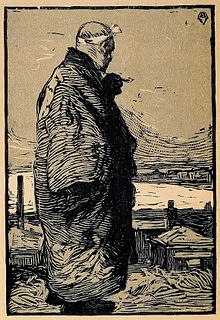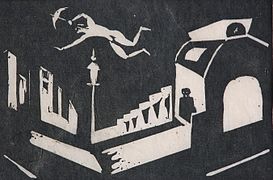Sōsaku-hanga
Sōsaku-hanga ( Japanese. 創作 版画 , literally: "creative printing") is a modern art movement in Japanese graphics, especially woodblock prints , which emerged at the beginning of the 20th century.
definition
Sōsaku-hanga , along with Shin-hanga, is one of the two art styles that developed in Japanese woodcut at the beginning of the 20th century. An important feature of Sōsaku-hanga are the principles of jiga (self-drawn), jikoku (self-carved) and jizuri (self-printed), that is, the artist himself carries out all three steps to create a woodcut - in accordance with European tradition . This was a departure from the traditional production of ukiyo-e , in which each work step was carried out by a different group of people (draftsman, carver, printer).
In contrast to painting with the strict separation into Japanese Nihonga and Western Yōga , the allocation in graphic art is not so clear. The Shin-hanga featured the "beautiful woman" ( bijinga ), the Kabuki actor, but it wasn't the only topic. The Sōsakau-hanga focused on the environment, but not everything was self-cut. The wood cutter Igami Bonkatsu ( 伊 上 凡 骨 , 1875–1933) played an important role, especially in the early stages . The Sōsaku-hanga also include lithographs and etchings.
Beginning at the end of the Meiji period
In the last decade of the Meiji period , literary and artistic groups were formed that published - often short-lived - member magazines. The first example of a Sōsaku-hanga , the woodcut “The Fisherman” by Yamamoto Kanae (1882-1946) was printed in 1904 in the magazine Myōjō ( 明星 , “Morning Star”) with correspondingly small dimensions, namely 14.4 × 10 cm . One can speak of a Sōsaku-hanga movement only a few years later. Magazines such as Hōsun ( 方寸 ,) and Shirakaba ( 白樺 , "The Birch") became important. The editors of the Shirakaba around Mushanokōji Saneatsu organized the first exhibition with Western graphics in Tokyo in October 1911: Beardsley , Klinger , Munch , a total of 36 artists with 183 prints were to be seen .
Since 1909, Bernard Leach (1882–1979) was back in Japan, who taught etching and made friends with the Shirakaba group. In lectures he conveyed the view of the English reformers in art and design around William Morris .
Taishō period
The Taishō period brought more artistic freedom after the strictly regulated Meiji period. In March 1914 another important exhibition took place, which - with reference to Herwarth Walden - was based on the magazine Der Sturm . In addition to Yamamoto, Tobari Kogan , Minami Kunzō and Tomimoto Kenkichi ( 富 本 憲 吉 , 1886–1963) were among the artists of this new direction.
Sakamoto Hanjirō (1882–1969) and the brothers Ishii Hakutei (1882–1958) and Ishii Kakuzō ( 石井鶴 三 , 1887–1946) are also counted among the Sōsaku-hanga designers , although they almost all had their drawings cut by Igami . Oda Kazuma ( 織田 一 磨 , 1882–1956) with his lithographs and others are also included. The Shōtō bijutsukan 1999 exhibition catalog lists almost fifty artists.
A number of artists joined forces and published the magazine Tsukuhae ( 月 映 , "moon shine") texts and prints in 1914/15 . These included Onchi Kōshirō (1891-1955), Fujimori Shizuo ( 藤森 静 雄 , 1891-1943) and Tanaka Kyōkichi ( 田中恭 吉 , 1892-1915). Onchi also worked his whole life as an organizer and promoter of the Sōsaku-hanga movement.
Parallel to Tsukuhae , the magazine Kamen ( 仮 面 , "The Mask") appeared in 1914 with Hasegawa Kiyoshi ( 長谷川 潔 , 1891–1980) and Nagase Yoshirō ( 永 瀬 義 郎 , 1891–1978) as important artists.
In 1917, Nakajima Shigetaro began editing Nihon fukei hanga . A total of ten series of five sheets each had been published by 1921.
A number of artists who created woodcuts are best known today as painters, for example Sakamoto, Yorozu Tetsugorō (1885–1927), Kishida Ryūsei .
Shōwa period until World War II
- Maekawa Sempan ( 前 川 千 帆 , 1888–1960), became known for cityscapes and pictures of rural women.
- Koizumi Kishio ( 小泉 癸巳 男 , 1893–1945)
- Kawanishi Hide ( 川西 秀 , 1894–1965), designed brightly colored views in and around Kobe.
- Hiratsuka Unichi ( 平 塚 運 一 , 1895–1997), also worked in the USA. Known above all for his black and white woodcuts.
- Fukazawa Sakuichi ( 深 沢 索 一 , 1896–1947)
- Taninaka Yasunori ( 谷中 安 規 , 1897–1946), designed a. a. Dream scenes in his "shadow theater".
- Hashimoto Okiie ( 橋本 興 家 , 1899 –1993), designer a. a. from prints of Japanese rock gardens.
- Azechi Umetarō ( 畦 地 梅太郎 , 1902–1999), initially produced landscapes and later strongly stylized “people from the country”.
- Munakata Shikō ( 棟 方志 功 , 1903–1975), lost his early work in the war, also designed large formats, which he called “board pictures” ( 板 版 ).
- Saitō Kiyoshi ( 斉 藤 清 , 1907–1997), created landscapes, figures, later emphasizing the surface.
- Ono Tadashige ( 小野 忠 重 , 1909–1990), printed color on a black background. "Contemporary witness".
- Fujimaki Yoshio ( 藤 牧 義夫 , 1911–1935?), First created strongly contoured prints, then tore open the edges. Fujimaki disappeared without a trace on September 2, 1935.
- Hagiwara Hideo ( 萩 原 英雄 , 1913–2007),
- Watanabe Sadao ( 渡邊 貞 夫 , 1913–1996), dealt with Christian motifs.
- Sekino Jun'ichirō ( 関 野 準 一郎 , 1914–1988), prolific designer of Japanese landscapes, views, portraits.
photos
Shōwa period after World War II
- Yoshida Masaji ( 吉田 政 次 , 1917–1971), designed abstract woodcuts.
- Komai Tetsurō ( 駒 井 哲 郎 , 1920–1976), u. a. Etchings in the Paul-Klee succession.
- Maki Haku ( 巻 白 , 1924–2000)
The Sōsaku hanga only experienced its international breakthrough after the Second World War at the first São Paulo Biennale in 1951, when the jury awarded Komai for an etching and Saitō Kiyoshi for a woodcut. Munakata Shikō was also represented at this biennial with a series of prints entitled In honor of Beethoven's 5th Symphony . Munakata was then awarded first prize in the printing category for his works Two Bodhisattva , Ten Great Disciples of the Shaka and Three Women Ascending, Three Women Descending in 1955 when he participated in his third biennial .
present
After the end of the Shin-hanga, the Sōsaku-hanga resulted in the globalized form of the hand-printing technique. To name are u. a .:
- Masuo Ikeda (1934–1997), lithographs of people, groups.
- Naoko Matsubara (1937-)
Remarks
- ↑ Even with the division of labor mentioned above, Schnitzer and Drucker did not implement mechanical templates, but rather contributed creatively to the success.
- ↑ "Square inch", "Tiny. The lexicon also offers" heart "as a translation
- ↑ Today best known as a potter.
literature
- Yamanashi kenritsu bijutsukan (Ed.): Kindai kara gendai he - mokuhanga no kakushin . 2005 catalog.
- Okamoto et al. a .: Kindai Nihon hanga no mikata . Tokyo bijutsu, 2004. ISBN 4-8087-0751-9 .
- Shibuya kuritsu shōtō bijutsukan (Ed.): Sōsaku hanga no tanjō (Birth of Sōsaku-hanga). Catalog 1999.
- Smith, L .: Modern Japanese Prints 1912-1989 . Cover River Press, New York, 1994. ISBN 1-55859-871-5 .
- Kanagawa kenritsu bijutsukan (Ed.): 1930-nendai no hangakatachi . 1987.
- Type: Japanese Print Revival . In Time , July 23, 1956.
- Kendall H. Brown: Impressions of Japan: Print Interactions East and West. In: Christine Javid (Ed.): Color Woodcut International. Japan, Britain, and America in the Early Twentieth Century. Chazen Museum of Art, Madison WI 2006, ISBN 0-932900-64-X , pp. 13-29 ( excerpt (Google) ).
- Helen Merritt: Modern Japanese Woodblock Prints. The early years. University of Hawaii Press, Honolulu HI 1990, ISBN 0-8248-1200-X .
- Helen Merritt, Nanako Yamada: Guide to Modern Japanese Woodblock Prints. 1900-1975. University of Hawaii Press, Honolulu HI 1995, ISBN 0-8248-1732-X .
- Kurt Shaw: Carnegie exhibit shows Japanese beauty. In: Pittsburg Tribune Review , February 22, 2007 ( HighBeam Research. (December 19, 2012) ).
- Alicia Volk: Made in Japan. The Postwar Creative Print Movement. Milwaukee Art Museum in association with University of Washington Press, Milwaukee WI 2005, ISBN 0-295-98502-X .
Web links
- Sōsaku hanga at Artelino ( Memento from October 4, 2008 in the Internet Archive )
- John Fiorillo: Sôsaku Hanga (Creative Prints: 創作 版画)
- SosakuHanga.net 創作 版画 - extensive website on art history and with numerous pictures.









